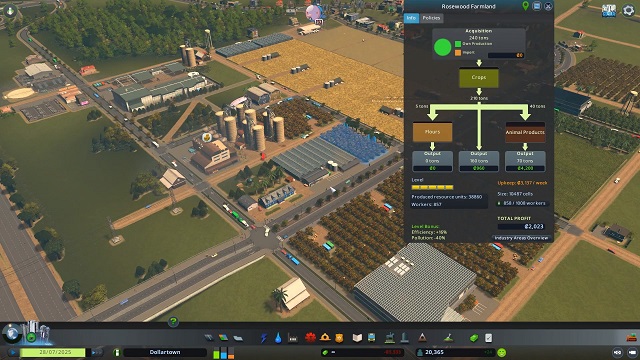So you took our advice and went and bought yourself the new Industries DLC for Cities: Skylines. Congratulations, you’ll be glad you did.
But instead of throwing a party for yourself, you’re probably looking at all those new features like “These look fun, but what am I going to DO with all of them?”
Well, we’ve got you covered, so read on. This step-by-step guide will turn you into a great industrialist in no time.
Step 1: Honestly, Consider Starting A New City
While you can easily redefine existing industrial areas using the DLC’s new tools, you’ll probably want to have a fresh map where you have the forests and fertile lands free (e.g. not already covered by other city services or buildings).
In order to get the most efficient use out of the new mechanics, you don’t want to have to do major urban renewal, so start on a blank slate and you’ll be perfectly prepared for the second step.
Step 2: Examine Your Map and Make Plans
Your resources are going to determine where your industrial zones are in this brave new Skylines world, which means that everything else you’re going to be building is going to be in service of your industries.
Commercial zones should be transport-accessible in the most efficient ways possible. This prevents bottlenecks that can keep finished goods from getting from the places they’re produced to the places where they’re sold to consumers.
Optimal Commercial Strategies
If you don’t already know (read: if you’re not someone that’s already put thousands of hours in Cities), here are some good strategies for building your commercial zones in Industries.
First and most importantly, remember that commercial zones, as always, act as a buffer between the pollution and crime that industry creates and the residential zones‘ hatred of both of those things. You can put commerce in a bit of a dingy neighborhood; you can’t do the same with residential. So as always, locating the commercial zones in between residence and industry is wise.
Beyond that, though, do consider that higher-end commercial zones are going to be far more voracious consumers of your industries’ output than are low-end zones. As such, you’ll want to make sure that the higher-value commercial areas are located close enough, but not too close, to your top-end industry buildings while still serving the very cream of the crop of residential areas.
It’s not too dissimilar to a classic basegame city layout; it’s just got more layers you need to concern yourself with if you’re going to make the most efficient use of the new industries.
Of course, residences are then placed as they always are, where citizens have access to their jobs and to shopping and services. That much hasn’t changed since the initial base game came out.
Step 3: How To Industry in Industries
The next part of this involves actually creating these specialized industrial zones. If you’ve played Parklife, you’ll know exactly how to start.
Draw a district over the raw resources (farming, forestry, ore, or oil) that are relevant to the industries that you’re building. It’s just like drawing a park boundary or a base game district.
Next, put down the main building; this will define which industrial category the entire area will produce. It’s just like the park types in Parklife.
After that, you’ll want to place the buildings that gather the raw materials; crop fields, logging camps, ore extraction, oil pumps, whatever is necessary for the industry you’re working with.
Pro tip: If you’re doing this for ore and oil, you should definitely tick on the option in the gameplay settings menu that gives you infinite oil and ore or you’re just going to strip them in about 10 minutes.
Now that you have the basics down, you’ll need to start making those supply chains happen so that resources can be improved into higher-value products and those products can be sold.
Step 4: Build Stuff to Make Stuff
The next step is to start putting down Warehouses and Processing Buildings.
Warehouses simply collect raw materials to make sure that A.) they have a place where your transport vehicles can pick them up and B.), you’ll have a constant supply to avoid temporary shortages in between times when the resources are being harvested.
Once that’s done, that’s where the processing buildings enter.
For forestry, this is the sawmill to turn logs into planed lumber. For farming, this is where raw crops become things like flour.
This is where you’ll start to see a real value-add to the resources you’re getting from those industrial zones.
Of course, you’ll need workers for all this, so don’t neglect the development of your city and education infrastructure while you’re improving your production chains.
Everything is designed to fit together, remember, so you’ll have a strong, granular level of control over the development of your industries that used to be at the whim of the game’s sometimes kludgy upgrade system for buildings.
Step 5: What To Do With All That Stuff

At the Special Processing level, you don’t necessarily have to start building “Unique Factories” yet. These intermediate products can be sold to ordinary industrial zones that aren’t part of the special resource areas. Furniture factories will buy your planks, food processors will buy your flour, and so on.
But you’ll eventually want to start building Unique Factories. Those are put there by the game to collect different products your industrial areas are producing to create, as the name implies, unique finished goods that are the most valuable goods of all.
Those Unique Factories produce luxury goods that can be both sold at a very high profit to your commercial zones and also exported.
In order to make use of them, you’ll need a bunch of resource chains working at once; a car factory, for example, needs Animal Products (leather for the seats), Plastics (from oil), and Glass and Metals (which come from ore extraction.)
And while some of those can be imported at a cost that will reduce the profit margin, you’re best off producing them all yourself.
The nice thing is that you can put Unique Factories anywhere on the map, so locating them fairly equidistant from all their resource inputs will make them more efficient.
Step 6: Sell Your Stuff!
Transport vehicles will visit your storage buildings, so make sure you’ve got good road connections into and out of the area where those buildings are. If you don’t, you’ll have massive traffic jams.
Here are some of our other guides regarding traffic and transportation that can help you out here:
- Cities: Skylines Mass Transit Traffic Guide
- Cities: Skylines Mass Transit DLC Transport System Guide
- A Guide to Using Cargo Trains in Cities: Skylines
On the bright side, there’s more to transport than cars. If you put your Warehouses near train hubs or the new Cargo Airport, you’ll be able to export your goods far more efficiently and with a massive reduction in road traffic compared to trying to truck everything down the highways.
Other than that, if you’ve dealt with air and rail traffic before, it’s the same ballgame — just re-purposed to carry all these new goods.
This is actually the easiest part for veteran Skylines players because it uses a mechanic as old as the base game and just specializes it.
Step 7: Have Fun With The Other Stuff
Separate from the industry chains is the new DLC’s mail system.
From now on, milestone Level 4 (Boom Town) now unlocks a new city service, the Post Office. Buildings generate mail, and that mail has to be delivered somewhere.
The system is similar to garbage trucks, except instead of dumping junk at the junkyard, junk mail is dumped in people’s mailboxes.
About once a month, a postal van will be generated that goes around, collects mail, and exports it offscreen to one of the off-map connecting neighbors.
The system is another city service; there’s really not much of a strategy to it beyond the usual keeping roads upgraded, so you can treat it like what it is.
Step 8: Level Up Your Stuff
Just like in Parklife, once your industries have produced enough and made enough profit, they’ll level up.
In addition, as the city gets bigger, bigger versions of industrial buildings will be unlocked, allowing for greater production, more workers, and all that other good stuff.
The strategy here is quite simple; it’s “the same, but more”, and you should be well able to figure this out as it comes up. If you’ve played Parklife, you already have experience with this system; if you haven’t, it’s basically: “This gains capacity so you don’t have to build a ton of different buildings or zones, you can level up the ones you have.”
To Summarize
- Industrial districts are necessary to use the resources they’re built on
- Extractor buildings extract raw materials
- Processing buildings turn them into industrial goods
- Unique Factories turn them into luxury goods
- And Warehouses enable planes, trains, and automobiles to turn them into money
Master that, and you’ll have an economic boom in no time.
The most important thing to remember is that this DLC may radically change the way you actually manage your industries, but this is still Skylines, which means that ultimately, it’s the same balancing act as it’s always been between the needs of all aspects of your society.
But once you get it right, the amount of money it brings in means you are well on your way to having an economic powerhouse, one that will let you make use of every resource on the map to create things that until now have only been abstract ideas.






Published: Oct 21, 2018 08:34 pm